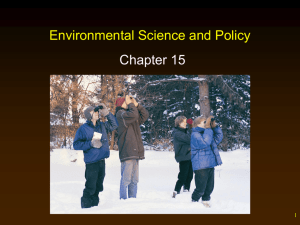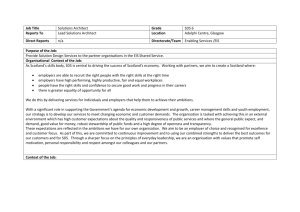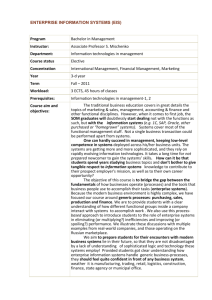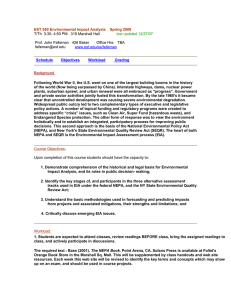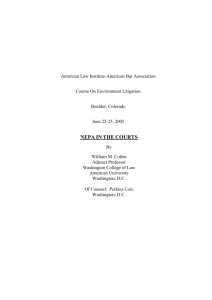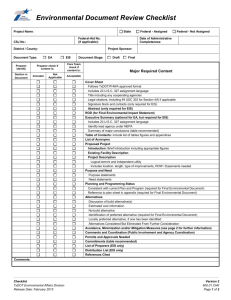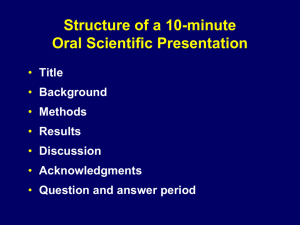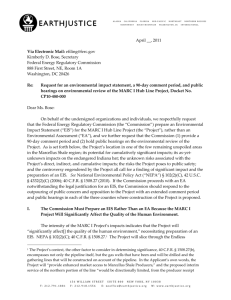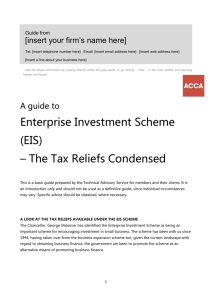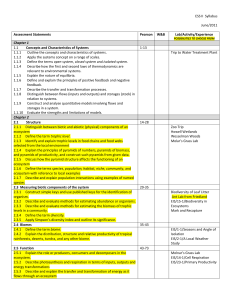Chapter 8: Major Elements
advertisement
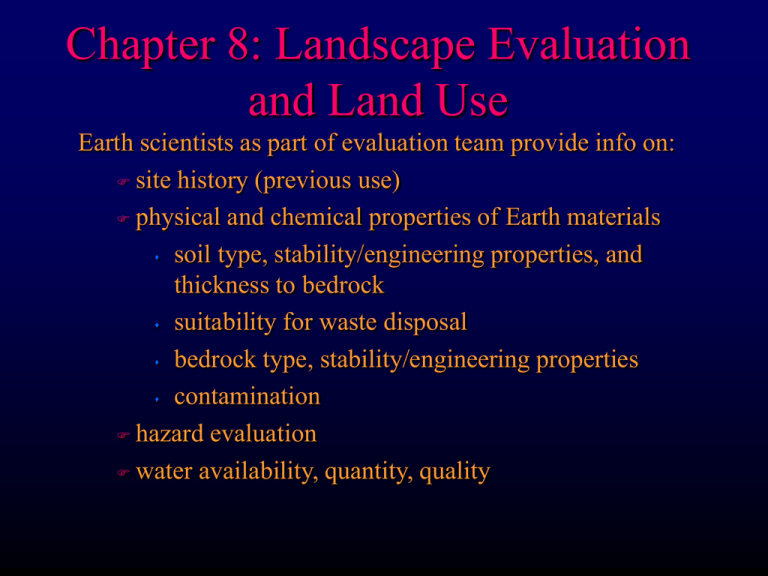
Chapter 8: Landscape Evaluation and Land Use Earth scientists as part of evaluation team provide info on: site history (previous use) physical and chemical properties of Earth materials soil type, stability/engineering properties, and thickness to bedrock suitability for waste disposal bedrock type, stability/engineering properties contamination hazard evaluation water availability, quantity, quality Environmental Geology Maps Distribution of geologic, hydrologic, etc. info. Interpretive Environmental Geology Maps Suitability of areas for a specific land use Ideally a series of maps, one for each possible land use Color code for suitability (yes, maybe, no) soil maps suitability for landfill stable foundations slope stability groundwater contamination earthquake vulnerability, etc. Environmental Geology Maps Map showing the vulnerability of aquifier contamination, New Mexico Environmental Geology Maps Map showing the major sources of potential groundwater contamination, New Mexico Environmental Geology Maps Environmental Resource Units (ERUs) Multidisciplinary approach: studies total natural environment (geo, hydro, bio) ERU = areas with similar physical and biological characteristics Used to establish patterns of land use and suitability in multidisciplinary approach Environmental Geology Maps Environmental Resource Units (ERUs) 10.4 km2 study site in Morrison Colorado test site Environmental Resource Units (ERUs) Mountain-forest Floodplain forest Pleistocene grassland Hogback wood and grassland scarp slope Hogback dip slope Environmental Geology Maps Geographic Information Systems (GIS) Computer composite maps capable of storing and displaying geographic distribution of anything The ability to combine and create maps of the combinations is a powerful technique Site Selection Evaluation of places for various human activities Can be quite multidisciplinary Assure that development is both possible and compatible with local environment Want to know all that you can before develop Site Selection Finally proceed to final site evaluation: specific criteria dep on intended use, but 2 common approaches: 1) Cost-Benefit Analysis Assess long-range desirability of a project Calculate estimates of total benefits in $ and compare to costs Best site has lowest C/B Site Selection Finally proceed to final site evaluation: specific criteria dep on intended use, but 2 common approaches: 2) Physiographic Determinism Apply ecological principles in design Maximize social benefit while minimizing social costs Consider physical, social, & aesthetic data of site itself do determine proper use and design Environmental Impact Statements (EIS) NEPA (1969) required all major federal actions which possibly affect the quality of the environment be preceded by an evaluation of the project and its impact Council of Environmental Quality set forth guidelines for EISs (revised in 1979) . The major components are: Summary Statement of purpose and need for the project Rigorous comparison of reasonable alternatives Succinct description of the area to be affected Environmental Impact Statements (EIS) Discussion of the environmental consequences of the proposed project and alternatives which must include: Direct and indirect effects Energy requirements and conservation Resource depletion Impact on urban quality and cultural/historical resources Possible conflicts with state and local land-use plans Mitigation measures Environmental Impact Statements (EIS) Scoping Initial NEPA EIS process criticized for mountains of paperwork that could obscure critical issues 1979 revisions introduced concept of scoping: preliminary identification of major environmental issues that require more detailed evaluation early in the process Environmental Impact Statements (EIS) Mitigation Identify actions that will avoid, lessen, or compensate for anticipated adverse impact If an action involves a wetland, may either avoid the wetland area or compensate by enhancing or creating wetland elsewhere NEPA requires address of this in EIS, but doesn’t require implementation of any measures However, DEIS is reviewed by many agencies and citizen’s groups that may require action Environmental Assessments in cases where full EIS deemed unnecessary Environmental Impact Statements (EIS) State Environment Impact Legislation About half of the states have followed the federal lead, either following NEPA for state and municipal projects or enacting their own SEPAs Environmental Impact Statements (EIS) Negative Declarations (D’s of non-significant impact) Filed when an agency determines no significant impact In lieu of full EIS: much less rigorous and need not consider alternatives Many try this first, but may be required to do full EIS if not grounds for ND Mitigated Negative Declarations Filed when decided that initial project would significant environment impact, but that it can be modified so as to reduce them to ~ insignificance Environmental Impact Statements (EIS) Big projects use teams of investigators with varied expertise Good case histories: Cape Hattaras San Joaquin Valley Land Use and Planning Most land use in USA is agriculture or forest Only about 3% or area is urban Conversion of rural non-ag is several thousand km2/yr ~ half wilderness, parks, recreation, wildlife ~ half urban, transportation, other facilities Scenic Resources Land Use Options Multiple Use Using the same land for > 1 purpose ball field doubles as aquifer recharge basin horse trails in floodplain wind generators in agricultural fields Sequential Use One use follows another Reclaimed mine used for underground storage, waste... Walla Walla landfill ballparks Gravel pits parking lots Land Use Planning Nation, State, or City may decide to enact land-use legislation for planning Comprehensive or General Plans Used as a policy guide for development decisions over a 10-20 yr period Sets forth intended basic land uses Indicates zoning and subdivision regulation Regulated in separate specific ordinances Control slopes, floodplain development, soils... Residential Commerical Industrial Open spaces Comprehensive or General Plans Land Management Follow-up to planning Possible impacts that need to be monitored Goals Natural processes: floods, landslides, erosion... Impact of human use on chemistry, biology, resources... Protection of lives and property Protection of water quality and supply Protection of wildlife Ecosystem protection Recreation and public access Emergency Planning (regulation of response) Environmental Law NEPA (National Environmental Policy Act) 1969, 1977 EPA establishes and enforces air and water quality standards Federal Water Pollution Act (1956) req. municipal sewage treatment Clean Air Act (1963) and Air Quality Act (1965) amended in 1970 and 1990: addresses all sorts of air pollution (autos, CFCs, ozone...) Solid Waste Disposal Act (1965) aimed at municipal dumps Resource Conservation and Recovery Act (1976) Toxic Substances and Control Act (1976) req. tests and control Clean Water Act (1977) addresses wider range of pollution CERCLA (Comprehensive Env. Resource, Compensation, and Liability Act) (1980) Superfund NEPA also set up requirement of EIS or EA (and enforces) CEQ (Council on Env. Quality) promotes interest and research in environment and implements

